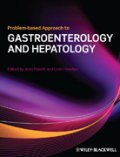
Problem-based approach to gastroenterology and hepatology
Plevris, John
Howden, Colin
INDICE: UPPER GI: Chapter 1: Clinical approach to Dysphagia and Odynophagia. Illustrated cases will cover several aspects of this alarm presenting symptom: oesophageal cancer, dysmotility syndromes, benign oesophageal strictures, eosinophilic oesophagitis, foreign bodies, infections such as herpes or CMV oesophagitis. Chapter 2: The problem of heartburn, nausea and vomiting and atypical chest pain Illustrated cases will cover several aspects of these symptoms: from symptomatic heartburn to Barretts oesophagus with varying degrees of dysplasia, dysmotility, syndromes, and various causes of nausea. vomiting from common to rare. Chapter 3: The clinical approach to dyspepsia Illustrative cases will systematically approach dyspepsia from the simple functional dyspepsia toall types of gastritis and peptic ulcer disease and to gastric cancer. The importance of other alarm symptoms co-existing with dyspepsia will be highlighted; cases presented as dyspepsia with diagnoses such as pancreatic cancer maybeincluded in this section. Chapter 4: Acute, recurrent acute and chronic abdominal pain Illustrative cases will help in dissecting surgical from medical causes of abdominal pains; again this very common symptom will be approached systematically from the gastric, pancreato-biliary and metabolic point of view. Chapter 5: Haematemesis, melaena and occult bleeding/ anaemia Illustrative caseswill deal with the problem of bleeding from the upper digestive system and small bowel. PANCREATO-BILIARY: Chapter 6: Clinical approach to jaundice Illustrative cases will cover the pancreato-biliary causes of jaundice-gallstone disease, pancreatic cancer, to more rare pancreato-biliary problems such as autoimmune pancreatitis and syndromes (Mirrizzi etc). Chapter 7: The problem of RUQpain This is a common referral symptom, which may be non-specific or indicatea variety of biliary problems from gallstone disease to sphincter of Oddi dysfunction. Illustrative cases will analyse this common symptom. LIVER: Chapter 8: The acute liver failure patient Illustrated cases from the Liver Unit of presentation and management of Acute liver failure patients including liver transplantation Chapter 9: The chronic liver disease patient: Illustrated cases from the Liver Unit of presentation and management of chronic liver disease patients from the pre-cirrhotic state to liver cirrhosis to listing for liver transplantation. Cases with development of hepatocellular carcinoma as a complication to cirrhosis may be included. Chapter 10: Portal hypertension a managementproblem: Illustrative cases will approach the problem of ascites, bleeding and encephalopathy in cirrhosis and management options such as TIPS, endoscopic treatments and pharmacological therapy. Chapter 11: The liver transplant patient: A selected small number of cases from the Transplant unit will serve to familiarise the trainee with aspects of post-transplant problems and care. Chapter 12: Abnormal liver
- ISBN: 978-1-4051-8227-0
- Editorial: Wiley-Blackwell
- Encuadernacion: Rústica
- Páginas: 272
- Fecha Publicación: 23/12/2011
- Nº Volúmenes: 1
- Idioma: Inglés
